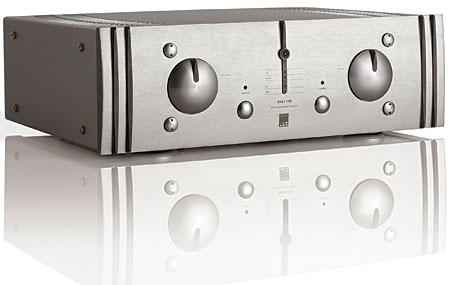| Columns Retired Columns & Blogs |
The Fifth Element #59 Page 3
I won't go on at length about the SCM 40's sound. The family resemblance to the SCM 11 was strong: it sounded like an excellent monitor speaker (which the SCM 11 is), except with more bass—and, for the price, unusually well-controlled, well-extended bass. I gather that some people hold to a stereotype that ATC speakers are for rock'n'rollers, by which I assume they mean large-scale dynamics, but also slammy bass and etched treble. Well, you can't prove that by me. Indeed, my sister-in-law listened to some Jane Monheit on the SCM 40s, then turned to me and said, "These speakers just sound 'sweet.'" I agree.
To sum up, the SCM 40 is an almost amazing value for the money. It's built in the UK by a company with as much heritage and credibility as you could ask for. As the top of ATC's entry-level line, it embodies the real-estate advice about buying the cheapest house on the nicest street. Its sealed-box bass loading makes it (as far as I know) unique among relatively affordable floorstanding loudspeakers. So, if Stereophile's "$$$" code (in "Recommended Components"), indicating exceptional value, could be given to a loudspeaker that costs more than $4000/pair (which I believe it can't be), I would plaster a "$$$" right on the SCM 40's front panel.
All of which is great. But I also have to point out that if someone charges a lot more for a speaker of the same size and the same general ambitions, he's not necessarily a charlatan, and he doesn't necessarily think you a dupe. A case in point is Wilson Benesch's sublime ACT. It's slightly taller than ATC's SCM 40, the same width, and slightly deeper, and its claimed –6dB point is 32Hz, but the ACT is a ported design. No surprise there. A layperson, seeing the two speakers side by side, might assume that the Wilson Benesch's swankier looks might indicate a price difference of a few hundred or a couple of thousand dollars. But in a wood-veneer finish, the ACT costs roughly five times as much as the SCM 40: over $20,000/pair. The Wilson Benesch has a hugely more expensive cabinet, veneers from the people who do the dashboards for Bentley cars, ultra-expensive drivers, and is made of two dozen different high-tech materials, principally carbon fiber.
The Wilson Benesch ACT's sound is so seamless that it is more often compared to that of Magneplanar panels than to the sound of any other speaker. Its powers of resolution are extraordinary. Yes, of course, the Wilson Benesch demonstrates diminishing marginal returns. But the existence of the ACT indicates that, in comparison, the SCM 40 is a cost-compromised contender. Even so, based on the kind of music I listen to and my sonic tastes, I think the SCM 40 strikes a wonderful balance—you, on the other hand, might give a careful listen to the SCM 19, and find that its more refined woofer-mid and (assumedly) simpler crossover might be just the ticket for you, and save you some money.
ATC SIA2 integrated amplifier: $5000
One of the most convincing arguments for active (ie, self-powered) loudspeakers is that they have what is, in effect, an external active crossover. That is, the frequencies are parceled out among the speaker's drive-units before rather than after amplification. Such a design has an obvious gain in efficiency, in that most passive, after-amplification crossovers must use resistors to set the relative levels of the drivers, and all the resistors end up doing is converting your expensive amplifier's expensive wattage into waste heat.

ATC has been in the professional-audio business since 1974, so it's not at all surprising that they offer a full line of active speakers for both professional and consumer use. What I find slightly surprising is that ATC has completed the circle by designing and building both an integrated amplifier, and separate preamplifier and power-amp models.
ATC's beefy (44 lbs) SIA2 integrated amplifier ($5000) puts out a claimed 150Wpc and is hand-built in the UK. It has five RCA inputs, but no phono stage, balanced inputs, or onboard digital capability requiring USB or S/PDIF connection; in two words, it's old school. And I love it. For me, the only two questionable aspects concern its casework. The styling is a bit art deco in the sense of 1930s Futurism—or Buck Rogers, if you like. The two large, moon-hubcap Input Selector and Volume knobs are okay, as are the two chrome buttons, each about ¾" in diameter, for Standby and Monitor. However, the four fasteners that seem to hold the faceplate on look as if they should control something. So the style is love it or don't. Also, the rear of the sheet-metal casework top seemed to float a bit free, though I never heard it actually rattle. And the headphone jack is around back.
I'm running out of space, so I'll reduce my sonic impressions to the equivalent of a haiku. The SIA2 exhibits all the virtues of a first-quality solid-state integrated amplifier. It costs $1500 more than the Luxman L-505u and offers fewer features (no tone controls or meters). But the SIA2 is even more authoritative-sounding than the entry-level Luxman, with a more "modern," less "retro" or "flattering" presentation, an apparently lower noise floor, and more resolving power—but the two amps are more alike than different in sound quality.
To sum up the SIA2: excellent performance, good value for money, and a great match for ATC's SCM 40 speakers. Indeed, the SCM 40s, the SIA2, and a BDP-83SE, Oppo Digital's new audiophile version of their universal Blu-ray player which Kalman Rubinson reviewed last month, should make for a very capable system of long-term value, complete with wires and cables, for $12,500 or less. Well done.
- Log in or register to post comments




































